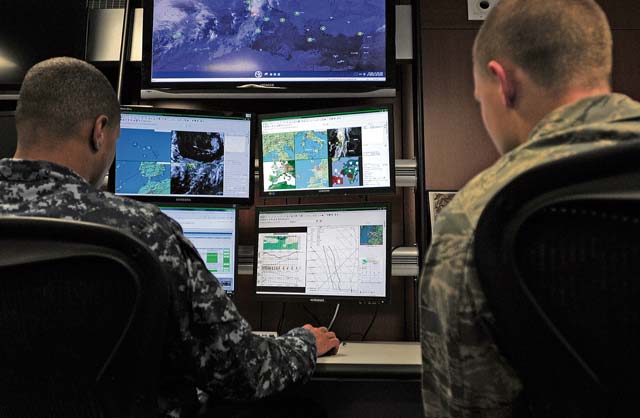
Aerographers Mate 1st Class Rhyan Winbush and 2nd Lt. Brian Popick, 21st Operational Weather Squadron weather forecasters, observe maps of different areas to predict the weather before participating in an evacuation exercise Oct. 24 at Kapaun Air Station. The 21st OWS conducts inspections every quarter to prepare operations at an alternate location if the primary location can’t be accessed.
Accurately forecasting the future weather of Europe, Africa, parts of Russia, the Middle East and Southwest Asia falls onto more than 100 pairs of shoulders belonging to the Airmen of the 21st Operational Weather Squadron stationed on Vogelweh. Their mission is to provide precise weather information used by war-fighters throughout the world.
“We establish a network of experts to form a conclusion of what we believe will happen and how it will affect the mission at large,” said Master Sgt. Raymond Ford, 21st OWS theater weather operations NCOIC. “Providing commanders and operators with highly accurate, timely and relevant environmental situation awareness in support of the U.S. Air Force, joint and command operations is critical in establishing successful operating procedures.”
Execution of airlifts, troop movements and protection of government property are still subject to weather patterns. By utilizing skilled technicians across multiple commands, the 21st helps predict and develop a plan in an ever-changing environment.
“Without the 21st, air operations would be extremely hazardous, ground missions would be impacted and the Air Force’s mission would suffer,” said Senior Airman Andrew Dudish, 21st OWS regional forecaster and weather briefer.
Weather forecasts are used to accurately plan flying missions, guard aircraft against inclement conditions and prepare the base infrastructure against the potential damage severe weather may cause.
“All flights out of our area of responsibility depend on weather support to provide the information needed to progress safely, effectively and successfully in the air,” said Staff Sgt. James Yonko, 21st OWS regional supervisor. “Forecasts allow locations to prepare for weather incident days in advance to prevent damage and destruction to the installation and potentially save lives on the ground and in the air.”
Understanding how weather may impact a mission is a heavy responsibility, and the 21st OWS Airmen use their expertise to mitigate one more variable in the chain of mission success.


